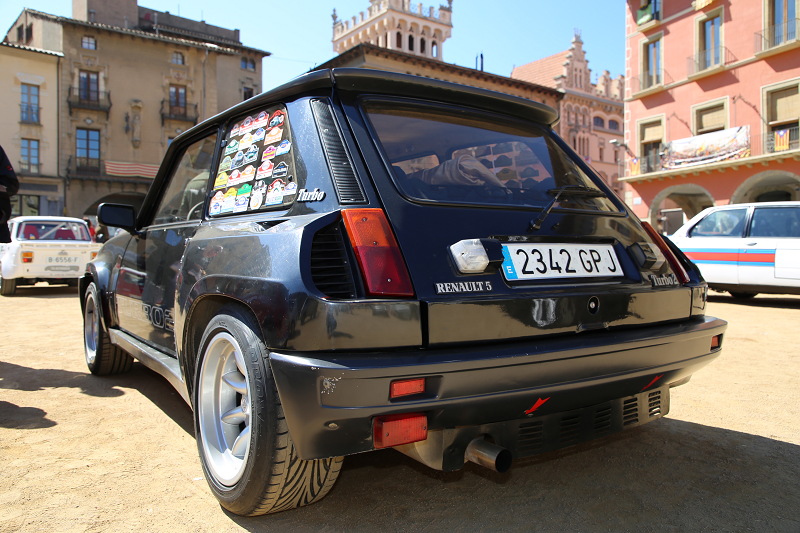Renault 5 turbo: black color in Catalonia (Spain)
The Renault 5 is a five-passenger, three or five-door, front-engine, front-wheel drive hatchback supermini manufactured and marketed by the French automaker Renault over two generations: 1972–1985 (also called R5) and 1984–1996 (also called Super 5 or Supercinq).
The R5 was marketed in the US and Canada as Le Car, from 1976 until 1983. Renault marketed a four-door sedan variant, the Renault 7, manufactured from 1974 until 1984 in Spain by Renault’s subsidiary FASA-Renault and exported to select markets.
First generation (1972–1985)
The first images and details of the Renault 5 were published on 10 December 1971, and the car’s formal launch followed on 28 January 1972.
The Renault 5 was styled by Michel Boué, who designed the car in his spare time, outside of his normal duties. When Renault executives learned of Boué’s work, they were so impressed by his concept that they immediately authorized a formal development program. The R5 featured a steeply sloping rear hatchback. Boué had wanted the tail-lights to go all the way up from the bumper into the C-pillar, in the fashion of the much later Fiat Punto and Volvo 850 estate/wagon, but the lights remained at a more conventional level.
It was launched onto the right-hand drive UK market in the autumn of 1972, where alongside the recently launched Fiat 127 it competed as an imported but more modern alternative to British Leyland’s Mini and Chrysler Europe’s Hillman Imp — and without competitors from Ford or Vauxhall.
The 5 narrowly missed out on the 1973 European Car of the Year award, which was instead given to the Audi 80.
Boué died of cancer at the end of 1972, just a few months after the car he designed was launched.
The R5 borrowed mechanicals from the successful Renault 4, using a longitudinally-mounted engine driving the front wheels with torsion bar suspension. OHV engines were the same as the Renault 4 and larger Renault 8. At the car’s launch, the 782 cc and 956 cc versions were available depending on the model level. A “5TS/5LS” with the 1,289 cc engine from the Renault 12 was added from April 1974. As on the Renault 4, entry-level Renault 5s had their engine sizes increased to 845 cc in 1976, and at the top of the range later models included the 1,397 cc version.
It was one of the first modern superminis, which capitalized on the new hatchback design, which Renault had patented on its R16, launched in 1965. It was launched a year after the booted version of the Fiat 127, and during the same year that the 127 became available with a hatchback.
The R5 was launched three years before the Volkswagen Polo and Vauxhall Chevette, and four years before the Ford Fiesta – new superminis which met the growing demand for this type of car in Western Europe. British Leyland was working on a new modern supermini during the 1970s, but the end product – the Austin Metro – was not launched until 1980. It was also introduced one year before the Toyota Starlet, while the Datsun 100A arrived in the UK starting in 1971. It was introduced six months before the Honda Civic which appeared later in July.
Sales in Japan began in 1976, where both the 2-door and 4-door were available at Capital Car Dealerships. It was called the “Renault Go” because that is the Japanese word for “five”. While originally sold with North American spec emissions equipment, it was changed to a French emissions package. The car was initially sold as left-hand drive, then upgraded to right-hand drive.
Although the mechanical components came from earlier models, body construction involved floor sections welded together with the other body panels, resulting in a monocoque structure.
The approach had by then become mainstream among many European automakers, but represented an advance on the mechanically similar Renault 4 and Renault 6 both of which used a separate platform. The monocoque structure reduced the car’s weight, but required investment in new production processes.
5 Turbo
The Renault 5 Turbo or R5 Turbo is a sport hatchback automobile launched by the French manufacturer Renault at the Brussels Motor Show in January 1980. The car was primarily designed for rallying, but was also sold in a street version.
A total of 4,987 (1,820 Turbo 1 and 3,167 Turbo 2) R5 Turbos were manufactured during the six-year production run.












